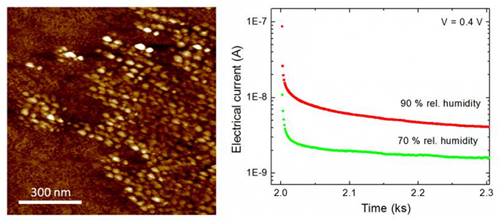Available in English only
Tetracene films for light-emitting transistors: chemical and physical effects of organic dielectric substrates
Tetracene vacuum-sublimed films have been used to demonstrate the first Organic Light Emitting Field Effect Transistor (OLEFET). Investigating the role played by the surface substrate chemistry and establishing sound structure-property relationships in organic semiconductor films incorporated into OLEFET structures are keys to understand and improve the optoelectronic characteristics of OLEFET. For this reason, we are currently studying the morphological (see Atomic Force Microscopy images below), structural, light-emission, and charge transport properties in field-effect transistor configuration of vacuum-sublimed tetracene films deposited on chemically and physically different organic dielectric substrates (HMDS- and OTS-treated SiO2, polystyrene, parylene, PMMA).

Related Publications
- J. Wunsche, G. Tarabella, S. Bertolazzi, M. Bocoum, N. Coppede, L. Barba, G. Arrighetti, L. Lutterotti, S. Iannotta, F. Cicoira, C. Santato. (2013). The Correlation Between Gate Dielectric, Film Growth, and Charge Transport in Organic Thin Film Transistros: The Case of Vacuum-Sublimed Tetracene Thin Films. Journal of Material Chemistry C, vol. 1, no. 5, pp. 967-976. http://pubs.rsc.org/en/content/articlepdf/2013/tc/c2tc00337f
- S. Bertolazzi, J. Wunsche, F. Cicoira, C. Santato. (2011). Tetracene thin film transistors with Polymer Gate Dielectrics. Applied Physics Letters, vol. 99. no. 1, 013301 (1-4).http://scitation.aip.org/content/aip/journal/apl/99/1/10.1063/1.3606535
Organic and hybrid electronic materials
Hybrid organic/inorganic materials offer the possibility to study and exploit functional properties that result from the synergy of the physical and chemical properties of the individual components.
We are currently investigating upconverting materials for solar energy conversion applications to extend to the near-infrared (NIR) the light harvesting properties of metal oxides, whose absorption is generally limited to the visible region of the solar spectrum. To do so, we fabricated nanocomposite films of UCNP and metal oxides.
Related Publications
- F. Venne, M. Quintanilla, D. Isik, F. Vetrone, C. Santaton. (2015). Towards Near-Infrared Photosensitization of Tungsten Trioxide Nanostructured Films by Upconverting Nanoparticles. Submitted.
In electrolyte-gated transistors, the exceptionally high capacitance of the electrical double layer forming at the electrolyte/transistor channel interface permits current modulations of several orders of magnitude, at relatively low gate voltages. The effect of the nature of the gate electrode on the performance of electrolyte-gated transistors is still largely unclear, despite recent intensive efforts.
The nature of the channel material is one of the key factors establishing the type of doping mechanism. For channel materials based on organic polymers, it is mainly Faradaic. For this class of channel materials, the doping charge and the (pseudo)capacitance are about two orders of magnitude larger than for electrostatically doped, non-porous materials.
Furthermore, we synthesize and characterize nanostructured metal oxide films interesting for photoelectrochemical applications (e.g. hydrogen production by water photoelectrolysis). To investigate the role played by interfacial effects on the charge transport properties of the films we are exploring the use of the electrolyte-gating approach.
Related Publications
- X. Meng, F. Quennenville, F. Venne, E. Di Mauro, D. Isik, M. Barbosa, Y. Drolet, M. Natile, D. Rochefort, F. Soavi, C. Santato. (2015). Electrolyte-Gated WO3 Transistors: Electrochemistry, Structure and Device Performance. The Journal of Physical Chemistry C. Submitted.
- J. Sayago, F. Soavi, Y. Sivalingam, F. Cicoira, C. Santato. (2014). Low Voltage Electrolyte-Gated Organic Transistors Making Use of High Surface Area Activated Carbon Gate Electrode, J. Mater. Chem. C, vol. 2, issue 28, 5690-5694. http://pubs.rsc.org/en/content/articlepdf/2014/tc/c4tc00864b
- J. Sayago, X. Meng, E. Bourbeau, F. Quenneville, F. Cicoira, F. Soavi, C. Santato. (2015). Electrolyte-Gated Polymer Thin Film Transistors Making Use of Ionic Liquids and Ionic Liquid-Solvent Mixtures. Journal of Applied Physics. vol 117, no. 11, 112809 (1-6). http://pubs.rsc.org/en/content/articlepdf/2014/tc/c4tc02119c
- J. Sayago, U. Shafique, F. Soavi, F. Cicoira, C. Santato. (2014). TransCap: a Monolithically Integrated Supercapacitor Andelectrolyte-Gated Transistor. J. Mater. Chem. C, vol. 2, pp. 10273–10276. http://pubs.rsc.org/en/content/articlepdf/2014/tc/c4tc02119c
- G. Tarabella, F. M. Mohammadi, N. Coppedé, F. Barbero, S. Iannotta, C. Santato and F. Cicoira. (2013). New Opportunities for Organic Electronic Devices: Ions in Action. Chemical Science, vol. 4, no. 4, pp. 1395-1409. http://pubs.rsc.org/en/content/articlepdf/2013/sc/c2sc21740f
Eumelanin thin films for bioelectronics
Eumelanin is a ubiquitous natural pigment that is potentially interesting for applications in organic bioelectronics due to its unique set of physicochemical properties including strong broad-band UV-Vis absorption, metal chelation properties, and potentially mixed electronic-ionic conduction in a hydrated state. Although eumelanin was discovered to have semiconductor-like properties already in the 1970s, its structural and charge transport properties are still poorly understood, largely due to its insoluble and heterogeneous nature. We are investigating the growth of solution-processed eumelanin thin films, their electrochemical, and electronic/ionic charge transport properties. We are also exploring the integration of eumelanin in electronic and electrochemical devices.

Related Publications
- M. d’Ischia, K. Wakamatsu, F. Cicoira, E. Di Mauro, J. C. Garcia-Borron, S. Commo, I. Galvàn, G. Ghanem, K.Kenzo, P. Meredith, A. Pezzella, C. Santato, T. Sarna, John. D. Simon, L. Zecca, F. A. Zucca, A. Napolitano, S. Ito. (2015). Melanin and Melanogenesis: From Pigment Cells to Human Health and Technological Applications. Pigment Cell and Melanoma Research. vol. 28, no. 5. pp. 520-544.http://onlinelibrary.wiley.com/doi/10.1111/pcmr.12393/abstract
- J. Wuensche, Y. Deng, P. Kumar, E. Di. Mauro, E. Josberger, J. Sayago. A. Pezzella, F. Soavi, F. Cicoira, M. Rolandi, C. Santato. (2014). Protonic and Electronic Transport in Hydrated Thin Films of the Pigment Eumelanin. Chemistry of Materials. 27: 436-442. vol 27, no. 2, pp. 436-442.http://pubs.acs.org/doi/abs/10.1021/cm502939r
- J. Wünsche, F. Cicoira, C. F. O. Graeff, C. Santato. (2013). Journal of Materials Chemistry B, vol. 1, pp. 3836-3842. http://pubs.rsc.org/en/content/articlepdf/2013/tb/c3tb20630k
- J. Wünsche, L. Cardenas, F. Rosei, F. Cicoira, R. Gauvin, C.F.O. Graeff, S. Poulin, A. Pezzella, and C. Santato. (2013). In Situ Formation of Dendrites in Eumelanin Thin Films Between Gold Electrodes. Advanced Functional Materials, vol. 23, no. 45, pp. 5591-5598. http://onlinelibrary.wiley.com/doi/10.1002/adfm.201300715/pdf


